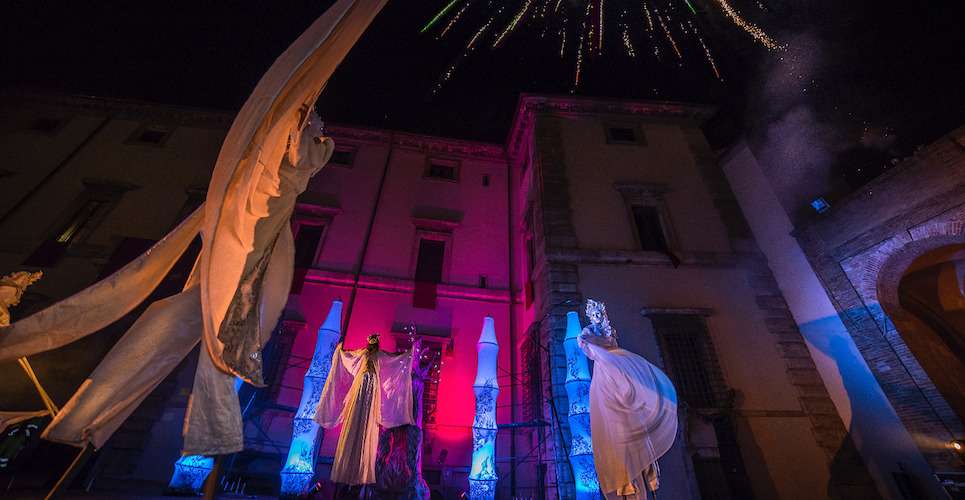Umbria is land of medieval villages, walls, castles and fortresses to visit. Umbria, land of great food and wine products, is land of silencewhere the nature is sovereign, perhaps for this reason it is the home of spirituality. Umbrians are San Francesco, San Benedetto, Santa Chiara and others, but it is also land of contrasts. It is in fact in Umbria, precisely ad Acquasparta (Tr)not far from the Romita di Cesi, a Franciscan hermitage where St. Francis began the drafting of his “Canticle of the Creatures” and an unmissable stop for pilgrims who walk the path of St. Francis, who science has left its mark, thanks to the presence of Federico Cesiwhich at the beginning of the seventeenth century, gave birth at the Accademia dei Lincei,there first scientific academy in Europe of which Galileo Galilei was also a member.
Acquasparta (Tr), which seems to derive from the Latin “to aquas partes“, That is the part, the territory of the waters, ancient city built on the ruins of a probable Roman settlement, near the municipium from Carsulaeoverlooks the valley of the stream Naia and look at the woods of the Martani Mountains.
The town rises between the springs dell’Amerino and Furapane, touched from the Antica Via Flaminia, is one of the most beautiful villages in Italy in Umbria. Despite being a typical medieval village, it is the emblem of the Renaissance in Umbria, represented by the architectures of Cesi Palacearound which the entire historic center winds and the Church of Santa Cecilia, where the tombs of the illustrious Cesi family are located.
In Acquasparta the link with the Renaissance is so strong that by now it has been celebrated for twenty-three years the arrival in the city of the enlightened Federico Cesi known as the Linceowho moved to Acquasparta shortly after the marriage with the young Artemisia Colonna, which took place in 1614.
Excellent opportunity for visit Acquasparta and its rich territory is in fact the “Renaissance Festival” to be held this year, from 11 to 26 June 2022a moment in which it will give life with scrupulous historical fidelity and strong involvement of the inhabitants, to the historical re-enactment of the celebrations that the small community organized on the occasion of the arrival of Federico Cesi, one of the most significant figures in the scientific culture of the early seventeenth century, one of the first proponents of post-Copernican astronomy in Italy, passionate student of natural sciences, especially botany.
For the2022 edition the event will have as main theme the “Theatrum Totius Naturae “ work begun and never finished by Federico Cesi, which should have been the New Great Naturalistic Scientific Encyclopediabuilt thanks to free experimental observation with innovative – for the time – technical research tools, the telescope and the microscope, of which the Lincei claimed the invention. Parades in period costumes, challenges between districts, shows, initiatives for children and the inevitable typical taverns, will be the ingredients of the XXIII edition of the “Renaissance Festival” which involves the three districts of the village – San Cristoforo, Old door And The Ghetto – that they compete for the “keys” of the city.
There “Renaissance Festival” will open with the “Grande Corteo delle Contrade ”entitled “Metamorphosis: the earth, the stars, man”, scheduled for the evening of Saturday 11 June, which in this edition sees the director Germano Rubbi coordinate the show in precious Renaissance clothes, enhanced by performances and representations on the theme of nature.
The three districts they will compete then during the fifteen days of celebration, in various competitions that the public can attend: the Gastronomic Competition which will see the processing of a recipe of Renaissance cuisine that this year will have like the truffle is the protagonistan excellent product of the territory, which has recently received the prestigious recognition of inclusion in the Representative List of Intangible Cultural Heritage UNESCO (Truffle hunting and quarrying in Italy: traditional knowledge and practices); the Great Game of the Goose, a living revival, in costume, of the board game whose origins, in its modern version, date back to the second half of the sixteenth century; there Competition of the Tamburinienriched by the spectacle of the flag wavers, and the Theater competition in which each district, with its own amateur actors, stages a free theatrical interpretation of a text written before 1630, reworked and adapted; in this edition the contrada companies will perform on texts by W. Shakespeare and F. De Rojas.
Multiple the collateral initiatives aimed at the public that will enrich the program, come on photographic walks discovering the territory, small and large animals, wild orchids, typical shrubs and trees; at wine tastings in the Renaissance rooms of Palazzo Cesi “In the glass of the celivago – A playful journey between wines and planets” a journey that combines the character of each wine with the discovery of the characters of the planets; ai theater show and acrobatic with a Renaissance theme and with pyrotechnic effects.
There will be gods moments dedicated to the little ones with “The Academy of the Little Lynx”A series of workshops related to the theme of science and scientific knowledge that will be based on observation in nature and on the use of the microscope as an instrument of wonder and discovery.
Several then cultural in-depth appointments, themed nature, food and wine, science, to which experts will speak: “Il Rinascimento fra magic, philosophy natural and science. From the universal animation of nature to regnum hominis ”, scheduled for June 12; “The Truffle, from Renaissance cuisine to our table ”scheduled for 13 June; “The art describing: from Tabule Phytosophicae to Naturalistic photography ”scheduled for June 16; “The Natural desire to know and the space of freedom: Giordano Bruno, Tommaso Campanella and the Lincei” scheduled for June 18; in addition to the meeting on Saturday 25 June dedicated to ancient fruits and the protection of biodiversity. Accompanied by Isabella Dalla Ragione of the Arboreal Archeology Foundationthe research project of ancient local fruit varieties, culminating in a “Orchard collection“Located near Montone (Pg), it will be possible to discover how the study of Renaissance works of art has helped researchers in identifying ancient varieties of fruit and native tree species, which in some cases were later recovered and cultivated so that they would not get lost.
To close the Acquasparta Renaissance Festival, Sunday 26 June 2022, on baroque music concert “To the war of love. Vocal and instrumental music in Italy between the end of the 1500s and the first decades of the 1600s “by the” La Selva Ensemble of Ancient Music “in which Riccardo Pisani – singing will perform; Carolina Pace – recorder; Michele Carreca – theorbo and baroque guitar.
Journey to Umbria between spirituality and science. Discovering Acquasparta – Traveling


